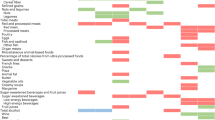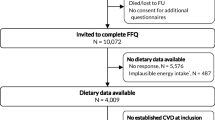Abstract
Background/objectives:
In men with established cardiovascular disease, the effect of diets with high glycemic index (GI) and glycemic load (GL) is unknown. We tested the hypothesis that diets with higher GI and GL are associated with increased mortality in men with established cardiovascular disease.
Subjects/methods:
We measured dietary GI and GL using food-frequency questionnaires in 4617 men, 45–79 years old, with a history of cardiovascular disease. The men were followed for cardiovascular mortality (6-year follow-up, 608 cases) and all-cause mortality (8-year follow-up, 1303 cases) using the Swedish cause-of-death and death registers. We used Cox models with age as the timescale and adjusted for body mass index, physical activity, history of hypertension and diabetes, family history of myocardial infarction, aspirin use, cigarette smoking and dietary factors to estimate incidence rate ratios (RRs).
Results:
Comparing top to bottom quartiles of dietary GI, the RR for cardiovascular mortality was 0.86 (95% confidence interval (CI) 0.67–1.10, P for linear trend=0.21), and the RR for all-cause mortality was 1.00 (95% CI 0.85–1.19, P for linear trend=0.87). Compared to quartile 1, the RR for men with dietary GL in quartile 4 was 1.02 (95% CI 0.70–1.49, P for linear trend=0.81) for cardiovascular and 1.15 (95% CI 0.89–1.49, P for linear trend=0.20) for all-cause mortality.
Conclusions:
In this population of men with prior cardiovascular disease, dietary GI and GL were not associated with cardiovascular or all-cause mortality.
This is a preview of subscription content, access via your institution
Access options
Subscribe to this journal
Receive 12 print issues and online access
$259.00 per year
only $21.58 per issue
Buy this article
- Purchase on Springer Link
- Instant access to full article PDF
Prices may be subject to local taxes which are calculated during checkout
Similar content being viewed by others
References
Amano Y, Kawakubo K, Lee JS, Tang AC, Sugiyama M, Mori K (2004). Correlation between dietary glycemic index and cardiovascular disease risk factors among Japanese women. Eur J Clin Nutr 58, 1472–1478.
Bergström L, Kylberg E, Hagman U, Erikson H, Bruce Å (1991). The food composition database KOST: the National Administration's information system for nutritive values of food. Vår Föda 43, 439–447.
Beulens JW, de Bruijne LM, Stolk RP, Peeters PH, Bots ML, Grobbee DE et al. (2007). High dietary glycemic load and glycemic index increase risk of cardiovascular disease among middle-aged women: a population-based follow-up study. J Am Coll Cardiol 50, 14–21.
Bouche C, Rizkalla SW, Luo J, Vidal H, Veronese A, Pacher N et al. (2002). Five-week, low-glycemic index diet decreases total fat mass and improves plasma lipid profile in moderately overweight nondiabetic men. Diabetes Care 25, 822–828.
Brand-Miller J, Hayne S, Petocz P, Colagiuri S (2003). Low-glycemic index diets in the management of diabetes: a meta-analysis of randomized controlled trials. Diabetes Care 26, 2261–2267.
Ebbeling CB, Leidig MM, Sinclair KB, Seger-Shippee LG, Feldman HA, Ludwig DS (2005). Effects of an ad libitum low-glycemic load diet on cardiovascular disease risk factors in obese young adults. Am J Clin Nutr 81, 976–982.
Flight I, Clifton P (2006). Cereal grains and legumes in the prevention of coronary heart disease and stroke: a review of the literature. Eur J Clin Nutr 60, 1145–1159.
Ford ES, Liu S (2001). Glycemic index and serum high-density lipoprotein cholesterol concentration among US adults. Arch Intern Med 161, 572–576.
Foster-Powell K, Holt SH, Brand-Miller JC (2002). International table of glycemic index and glycemic load values: 2002. Am J Clin Nutr 76, 5–56.
Frost G, Leeds AA, Dore CJ, Madeiros S, Brading S, Dornhorst A (1999). Glycaemic index as a determinant of serum HDL-cholesterol concentration. Lancet 353, 1045–1048.
Halton TL, Willett WC, Liu S, Manson JE, Albert CM, Rexrode K et al. (2006). Low-carbohydrate-diet score and the risk of coronary heart disease in women. N Engl J Med 355, 1991–2002.
Jenkins DJ, Wolever TM, Taylor RH, Barker H, Fielden H, Baldwin JM et al. (1981). Glycemic index of foods: a physiological basis for carbohydrate exchange. Am J Clin Nutr 34, 362–366.
Larsson SC, Rutegard J, Bergkvist L, Wolk A (2006). Physical activity, obesity, and risk of colon and rectal cancer in a cohort of Swedish men. Eur J Cancer 42, 2590–2597.
Levitan EB, Mittleman MA, Hakansson N, Wolk A (2007a). Dietary glycemic index, dietary glycemic load, and cardiovascular disease in middle-aged and older Swedish men. Am J Clin Nutr 85, 1521–1526.
Levitan EB, Westgren CW, Liu S, Wolk A (2007b). Reproducibility and validity of dietary glycemic index, dietary glycemic load, and total carbohydrate intake in 141 Swedish men. Am J Clin Nutr 85, 548–553.
Liu S, Manson JE, Buring JE, Stampfer MJ, Willett WC, Ridker PM (2002). Relation between a diet with a high glycemic load and plasma concentrations of high-sensitivity C-reactive protein in middle-aged women. Am J Clin Nutr 75, 492–498.
Liu S, Manson JE, Stampfer MJ, Holmes MD, Hu FB, Hankinson SE et al. (2001). Dietary glycemic load assessed by food-frequency questionnaire in relation to plasma high-density-lipoprotein cholesterol and fasting plasma triacylglycerols in postmenopausal women. Am J Clin Nutr 73, 560–566.
Liu S, Willett WC, Stampfer MJ, Hu FB, Franz M, Sampson L et al. (2000). A prospective study of dietary glycemic load, carbohydrate intake, and risk of coronary heart disease in US women. Am J Clin Nutr 71, 1455–1461.
Ludwig DS (2002). The glycemic index: physiological mechanisms relating to obesity, diabetes, and cardiovascular disease. JAMA 287, 2414–2423.
McKeown NM, Meigs JB, Liu S, Saltzman E, Wilson PW, Jacques PF (2004). Carbohydrate nutrition, insulin resistance, and the prevalence of the metabolic syndrome in the Framingham Offspring Cohort. Diabetes Care 27, 538–546.
McMillan-Price J, Petocz P, Atkinson F, O'Neill K, Samman S, Steinbeck K et al. (2006). Comparison of 4 diets of varying glycemic load on weight loss and cardiovascular risk reduction in overweight and obese young adults: a randomized controlled trial. Arch Intern Med 166, 1466–1475.
Messerer M, Johansson SE, Wolk A (2004). The validity of questionnaire-based micronutrient intake estimates is increased by including dietary supplement use in Swedish men. J Nutr 134, 1800–1805.
Mozaffarian D, Rimm EB, Herrington DM (2004). Dietary fats, carbohydrate, and progression of coronary atherosclerosis in postmenopausal women. Am J Clin Nutr 80, 1175–1184.
Oh K, Hu FB, Cho E, Rexrode KM, Stampfer MJ, Manson JE et al. (2005). Carbohydrate intake, glycemic index, glycemic load, and dietary fiber in relation to risk of stroke in women. Am J Epidemiol 161, 161–169.
Pereira MA, Swain J, Goldfine AB, Rifai N, Ludwig DS (2004). Effects of a low-glycemic load diet on resting energy expenditure and heart disease risk factors during weight loss. JAMA 292, 2482–2490.
Salmeron J, Manson JE, Stampfer MJ, Colditz GA, Wing AL, Willett WC (1997). Dietary fiber, glycemic load, and risk of non-insulin-dependent diabetes mellitus in women. JAMA 277, 472–477.
Sloth B, Krog-Mikkelsen I, Flint A, Tetens I, Bjorck I, Vinoy S et al. (2004). No difference in body weight decrease between a low-glycemic-index and a high-glycemic-index diet but reduced LDL cholesterol after 10-wk ad libitum intake of the low-glycemic-index diet. Am J Clin Nutr 80, 337–347.
Slyper A, Jurva J, Pleuss J, Hoffmann R, Gutterman D (2005). Influence of glycemic load on HDL cholesterol in youth. Am J Clin Nutr 81, 376–379.
Smith Jr SC, Allen J, Blair SN, Bonow RO, Brass LM, Fonarow GC et al. (2006). AHA/ACC guidelines for secondary prevention for patients with coronary and other atherosclerotic vascular disease: 2006 update: endorsed by the National Heart, Lung, and Blood Institute. Circulation 113, 2363–2372.
Tavani A, Bosetti C, Negri E, Augustin LS, Jenkins DJ, La Vecchia C (2003). Carbohydrates, dietary glycaemic load and glycaemic index, and risk of acute myocardial infarction. Heart 89, 722–726.
van Dam RM, Visscher AW, Feskens EJ, Verhoef P, Kromhout D (2000). Dietary glycemic index in relation to metabolic risk factors and incidence of coronary heart disease: the Zutphen Elderly Study. Eur J Clin Nutr 54, 726–731.
Willett WC (1998). Nutritional Epidemiology. Oxford University Press: New York.
Acknowledgements
The Cohort of Swedish Men was supported by grants from the Swedish Research Council/Longitudinal Studies. Dr Levitan was supported by a grant from the Swedish Foundation for International Cooperation in Research and Higher Education and National Institutes of Health training Grant HL 7374.
Author information
Authors and Affiliations
Corresponding author
Additional information
Contributors: EBL and MAM contributed to the design of the study, the analysis and the manuscript. AW contributed to the design of the study, the analysis, the manuscript and collected the data.
Rights and permissions
About this article
Cite this article
Levitan, E., Mittleman, M. & Wolk, A. Dietary glycemic index, dietary glycemic load and mortality among men with established cardiovascular disease. Eur J Clin Nutr 63, 552–557 (2009). https://doi.org/10.1038/sj.ejcn.1602970
Received:
Revised:
Accepted:
Published:
Issue Date:
DOI: https://doi.org/10.1038/sj.ejcn.1602970
Keywords
This article is cited by
-
Dietary glycemic index, glycemic load, and cause-specific mortality: two population-based prospective cohort studies
European Journal of Clinical Nutrition (2022)
-
Associations of Glycemic Index and Glycemic Load with Cardiovascular Disease: Updated Evidence from Meta-analysis and Cohort Studies
Current Cardiology Reports (2022)



